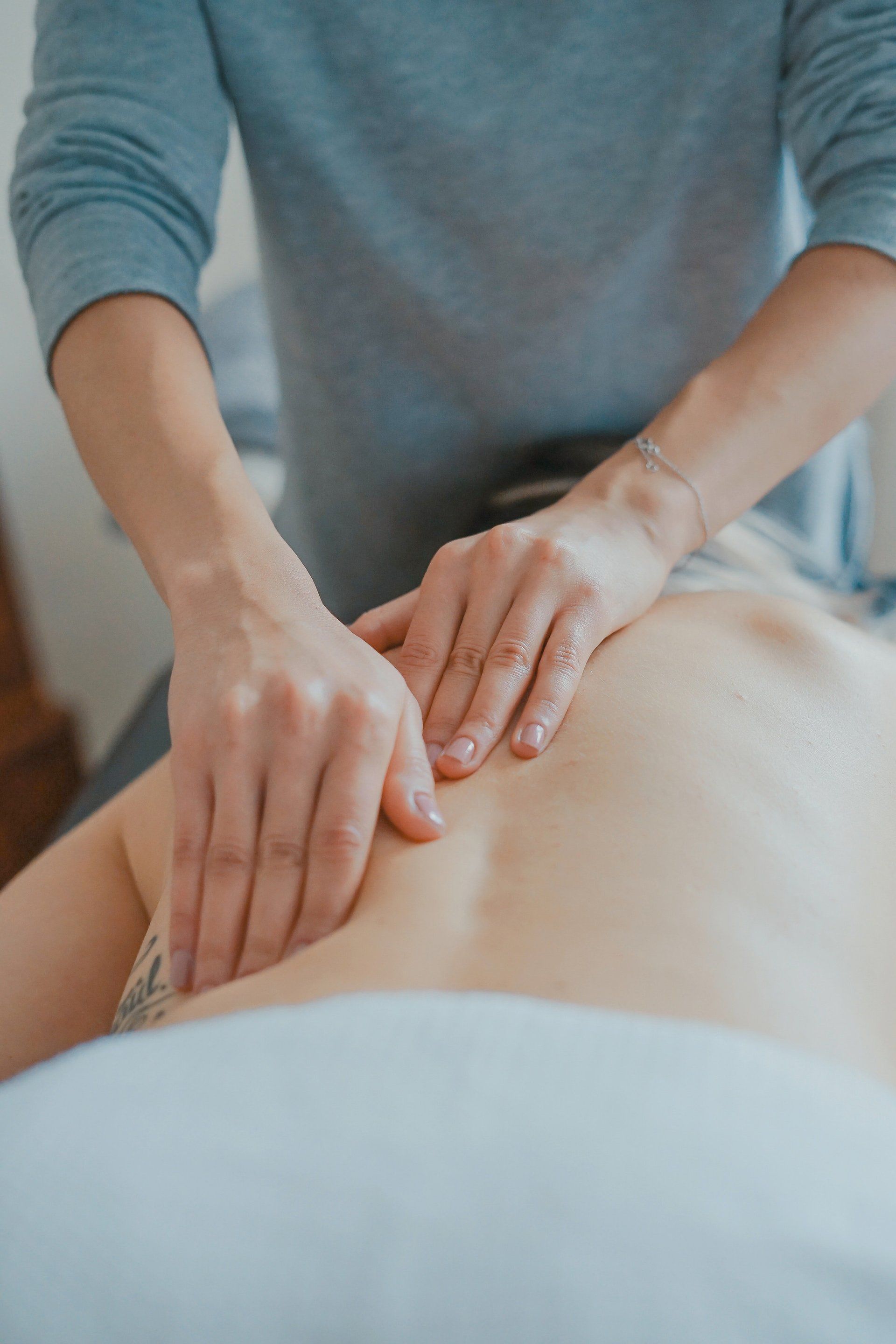Blog Layout
Posture and back pain
Oct 03, 2022
Does bad posture cause back pain?
Most people think that by sitting up straight, they're looking after their spines but for a while now, researchers and clinicians have found a lack of evidence of the relationship between posture and pain. That's not to say posture can't play a part when you're in pain but just sitting straight and adopting "good posture" won't stop you getting back pain. As usual exercise and movement is vital to keeping us healthy.
This article featured in the Guardian, co-authored by renowned Physiotherapist and researcher Peter O'Sullivan is a great round up of factors that may (and those that may not!) contribute to back pain.
Share
Tweet
Share
Mail
Blogs

by Carol Wells
•
22 Aug, 2022
Sciatica is simply a term for pain that starts in the lower back or buttock and travels into one (most commonly) or both (much less common) legs . It is important to remember that sciatica is a description of symptoms and not a diagnosis in itself. It's a bit like saying you have a headache...there can be many causes and therefore treatment is not always the same for each presentation or person. Sciatic pain often varies in its’ intensity and frequency, however often there will be a component of sharp, jabbing or “electric shock” pain that radiates into the leg. This usually is due to pressure on the nerve at some point. Dull, aching and heavy sensations can be irritation to nerve sensitive structures, but the nerve itself may not be compressed. Sciatica pain is also commonly associated with burning, numbness and tingling sensations. Sometimes the leg can feel heavy. Symptoms such as numbness and muscle weakness do require assessing and careful monitoring. Typically, sciatica is made worse by flexion-based activities, such as bending, lifting, sneezing and coughing. Sciatica can affect anyone in any walk of life, the causes and treatment are often different however. Most sciatica will settle and leave you with no long-term effects however please see the advice below. I MPORTANT IF YOU EXPERIENCE NUMBNESS IN THE SADDLE AREA (the bit that would be in contact with the saddle if you were sitting on a horse!) OR PROGRESSIVLEY WORSENING WEAKNESS IN THE LEG OR NEW ONSET BLADDER OR BOWEL INCONTINENCE (or inability to pass water despite feeling the urge) OR SEXUAL DYSFUNCTION associated with your sciatica you should seek URGENT MEDICAL ADVICE (go to A&E or call 111) . It is very rare but CES (cauda equina syndrome) can affect the nerves supplying these areas and left untreated can cause permanent damage. See the link below for helpful information cards in numerous languages on what symptoms to watch out for.

by Carol Wells MCSP
•
29 Oct, 2019
1. Your back is stronger than you think Most people worldwide will experience back pain during their lifetime. It can be disabling and worrying but it is very common and rarely dangerous. The spine is a strong, stable structure and not easily damaged so in most instances it is a simple sprain or strain. In most cases – 98 per cent, according to research – people recover reasonably quickly, and many do so without treatment. Some people experience repeat episodes, which can be distressing, but again these are rarely dangerous. 2. You rarely need a scan and it can do more harm than good This is because seeing perfectly normal changes to their spine can cause people to avoid the activities they should be doing to get better, such as exercise and movement in general. We now know that most people who have never had back pain have changes seen on x-ray or MRI and they can be completely normal part of the ageing process once we reach adulthood. In very rare cases, there may be something more serious or underlying that requires medical advice. A scan may help with your diagnosis and symptoms to be aware of are at the bottom of this page. However, these account for just two per cent of cases so if your physio or GP does not send you for one, you should take it as a good sign that there is nothing concerning going on. 3. Avoid bedrest, try to stay in work and gradually resume normal activitie s Scientific studies now indicate prolonged rest and avoidance of activity for people with low back pain actually leads to higher levels of pain, greater disability, poorer recovery and longer absence from work. In the first few days of a new episode of low back pain, avoiding aggravating activities may help to relive pain. However, staying as active as possible and returning to all usual activities gradually is actually important in aiding recovery – this includes staying in work where possible. While it is normal to move differently and more slowly in the first few days of having back pain, this altered movement can be unhealthy if continued in the long-term. 4. You should not fear bending and lifting Bending and lifting are often portrayed as causes of back pain and while an injury can occur if something is picked up in an awkward or unaccustomed way, it’s most likely to just be a sprain or strain. The important thing is to practice and get your body used to carrying different loads and weights in a way we find comfortable and efficient. We all work differently, and it’s perfectly normal for us to find our own technique for lifting. Generally, most people find that having a wide base (feet apart) and using the legs can reduce the work-load on the back. 5. Exercise and activity can reduce and prevent back pain Exercise is shown to be very helpful for tackling back pain and is also the most effective strategy to prevent future episodes. Start slowly and build up both the amount and intensity of what you do and don’t worry if it’s sore to begin with – you won’t be damaging your back. If you’re unsure ask your physio for advice. No one type of exercise is proven to be more effective than others so just pick an exercise you enjoy, that you can afford to maintain in the long-term and that fits in with your daily schedule. 6. Painkillers will not necessarily speed up your recovery There is no strong evidence on the benefits of painkillers and they do not speed up recovery. They should only be used in conjunction with other measures, such as exercise, and even then just as a short-term option as they can bring side effects. Sometimes though they can help you to feel more able to move and exercise and this can aid recovery Exercise, which is safer and cheaper, is considered the preferred option in most cases. 7. Surgery is rarely needed There are some uncommon back conditions where there is pressure on the nerves that supply the legs and the patient gets leg symptoms, such as pain, pins and needles or numbness. For these conditions, surgery can sometimes help the leg symptoms but it is important to understand that it is not always required. You also need to know that on average, the results for back surgery are no better in the medium and long term than non-surgical interventions, such as exercise. So a non-surgical option, which includes exercise and activity, should always come first. 8. Good quality sleep is important The importance of sleep in tackling back pain has become increasingly clear in recent years. This is because it reduces stress and improves your overall feeling of well-being, making you less susceptible to the triggers of pain in the first instance and helping you to cope when it does occur. Aim for 7.5-8 hours a night and try to aim for a regular routine, as far as possible. It is also very important to know that there is no best position or type of mattress – whatever feels most comfortable for you is best. 9. You can have back pain without any damage or injury Many physical or psychological factors can cause back pain and often a combination of these are involved. They could be - Physical factors, such as ‘protecting’ the back and avoiding movements, or a simple strain. - Psychological factors, including a fear of damage or not getting better, feeling down or being stressed. - More general health and lifestyle factors, like being tired and rundown, not getting enough good quality sleep, being overweight or not getting enough physical activity - Social triggers, such as difficult relationships at work or home, low job satisfaction or stressful life events, like a family death or illness. Crucially, it’s important to know that all pain is 100 per cent real and never ‘all in your head’, even when factors like stress or mood are involved. Each of the factors can turn up the volume on your pain and gaining a greater understanding of when that can happen puts you in a stronger position to recognise them and learn how to turn down the dial again. If it doesn’t clear up, seek help but don’t worry If your back pain does not clear up after 6 – 8 weeks, make an appointment to see your GP or physiotherapist Physiotherapists provide expert advice, guidance and treatment for back pain. This is to help reduce your chances of future episodes, while improving your overall health and wellbeing. 10. Symptoms to be aware of: These symptoms are very rare but you should contact a doctor if you experience any of them: Difficulty passing urine or having a sensation to pass water that is not there Numbness/tingling in your genitals or buttocks area Unexplained loss of bladder or bowel control Impaired sexual function, such as loss of sensation during intercourse Loss of power in your legs Feeling unwell with your back pain, such as a fever or significant sweating that wakes you from sleep Of course, if you have any questions or want to book an appointment with your physiotherapist, give me a call on 07507 490888 and I’ll be happy to help. This post contains information from the CSP Website 2019.
I'll be posting some useful information and advice here so please check back regularly for new posts.
Blogs

by Carol Wells
•
22 Aug, 2022
Sciatica is simply a term for pain that starts in the lower back or buttock and travels into one (most commonly) or both (much less common) legs . It is important to remember that sciatica is a description of symptoms and not a diagnosis in itself. It's a bit like saying you have a headache...there can be many causes and therefore treatment is not always the same for each presentation or person. Sciatic pain often varies in its’ intensity and frequency, however often there will be a component of sharp, jabbing or “electric shock” pain that radiates into the leg. This usually is due to pressure on the nerve at some point. Dull, aching and heavy sensations can be irritation to nerve sensitive structures, but the nerve itself may not be compressed. Sciatica pain is also commonly associated with burning, numbness and tingling sensations. Sometimes the leg can feel heavy. Symptoms such as numbness and muscle weakness do require assessing and careful monitoring. Typically, sciatica is made worse by flexion-based activities, such as bending, lifting, sneezing and coughing. Sciatica can affect anyone in any walk of life, the causes and treatment are often different however. Most sciatica will settle and leave you with no long-term effects however please see the advice below. I MPORTANT IF YOU EXPERIENCE NUMBNESS IN THE SADDLE AREA (the bit that would be in contact with the saddle if you were sitting on a horse!) OR PROGRESSIVLEY WORSENING WEAKNESS IN THE LEG OR NEW ONSET BLADDER OR BOWEL INCONTINENCE (or inability to pass water despite feeling the urge) OR SEXUAL DYSFUNCTION associated with your sciatica you should seek URGENT MEDICAL ADVICE (go to A&E or call 111) . It is very rare but CES (cauda equina syndrome) can affect the nerves supplying these areas and left untreated can cause permanent damage. See the link below for helpful information cards in numerous languages on what symptoms to watch out for.

by Carol Wells MCSP
•
29 Oct, 2019
1. Your back is stronger than you think Most people worldwide will experience back pain during their lifetime. It can be disabling and worrying but it is very common and rarely dangerous. The spine is a strong, stable structure and not easily damaged so in most instances it is a simple sprain or strain. In most cases – 98 per cent, according to research – people recover reasonably quickly, and many do so without treatment. Some people experience repeat episodes, which can be distressing, but again these are rarely dangerous. 2. You rarely need a scan and it can do more harm than good This is because seeing perfectly normal changes to their spine can cause people to avoid the activities they should be doing to get better, such as exercise and movement in general. We now know that most people who have never had back pain have changes seen on x-ray or MRI and they can be completely normal part of the ageing process once we reach adulthood. In very rare cases, there may be something more serious or underlying that requires medical advice. A scan may help with your diagnosis and symptoms to be aware of are at the bottom of this page. However, these account for just two per cent of cases so if your physio or GP does not send you for one, you should take it as a good sign that there is nothing concerning going on. 3. Avoid bedrest, try to stay in work and gradually resume normal activitie s Scientific studies now indicate prolonged rest and avoidance of activity for people with low back pain actually leads to higher levels of pain, greater disability, poorer recovery and longer absence from work. In the first few days of a new episode of low back pain, avoiding aggravating activities may help to relive pain. However, staying as active as possible and returning to all usual activities gradually is actually important in aiding recovery – this includes staying in work where possible. While it is normal to move differently and more slowly in the first few days of having back pain, this altered movement can be unhealthy if continued in the long-term. 4. You should not fear bending and lifting Bending and lifting are often portrayed as causes of back pain and while an injury can occur if something is picked up in an awkward or unaccustomed way, it’s most likely to just be a sprain or strain. The important thing is to practice and get your body used to carrying different loads and weights in a way we find comfortable and efficient. We all work differently, and it’s perfectly normal for us to find our own technique for lifting. Generally, most people find that having a wide base (feet apart) and using the legs can reduce the work-load on the back. 5. Exercise and activity can reduce and prevent back pain Exercise is shown to be very helpful for tackling back pain and is also the most effective strategy to prevent future episodes. Start slowly and build up both the amount and intensity of what you do and don’t worry if it’s sore to begin with – you won’t be damaging your back. If you’re unsure ask your physio for advice. No one type of exercise is proven to be more effective than others so just pick an exercise you enjoy, that you can afford to maintain in the long-term and that fits in with your daily schedule. 6. Painkillers will not necessarily speed up your recovery There is no strong evidence on the benefits of painkillers and they do not speed up recovery. They should only be used in conjunction with other measures, such as exercise, and even then just as a short-term option as they can bring side effects. Sometimes though they can help you to feel more able to move and exercise and this can aid recovery Exercise, which is safer and cheaper, is considered the preferred option in most cases. 7. Surgery is rarely needed There are some uncommon back conditions where there is pressure on the nerves that supply the legs and the patient gets leg symptoms, such as pain, pins and needles or numbness. For these conditions, surgery can sometimes help the leg symptoms but it is important to understand that it is not always required. You also need to know that on average, the results for back surgery are no better in the medium and long term than non-surgical interventions, such as exercise. So a non-surgical option, which includes exercise and activity, should always come first. 8. Good quality sleep is important The importance of sleep in tackling back pain has become increasingly clear in recent years. This is because it reduces stress and improves your overall feeling of well-being, making you less susceptible to the triggers of pain in the first instance and helping you to cope when it does occur. Aim for 7.5-8 hours a night and try to aim for a regular routine, as far as possible. It is also very important to know that there is no best position or type of mattress – whatever feels most comfortable for you is best. 9. You can have back pain without any damage or injury Many physical or psychological factors can cause back pain and often a combination of these are involved. They could be - Physical factors, such as ‘protecting’ the back and avoiding movements, or a simple strain. - Psychological factors, including a fear of damage or not getting better, feeling down or being stressed. - More general health and lifestyle factors, like being tired and rundown, not getting enough good quality sleep, being overweight or not getting enough physical activity - Social triggers, such as difficult relationships at work or home, low job satisfaction or stressful life events, like a family death or illness. Crucially, it’s important to know that all pain is 100 per cent real and never ‘all in your head’, even when factors like stress or mood are involved. Each of the factors can turn up the volume on your pain and gaining a greater understanding of when that can happen puts you in a stronger position to recognise them and learn how to turn down the dial again. If it doesn’t clear up, seek help but don’t worry If your back pain does not clear up after 6 – 8 weeks, make an appointment to see your GP or physiotherapist Physiotherapists provide expert advice, guidance and treatment for back pain. This is to help reduce your chances of future episodes, while improving your overall health and wellbeing. 10. Symptoms to be aware of: These symptoms are very rare but you should contact a doctor if you experience any of them: Difficulty passing urine or having a sensation to pass water that is not there Numbness/tingling in your genitals or buttocks area Unexplained loss of bladder or bowel control Impaired sexual function, such as loss of sensation during intercourse Loss of power in your legs Feeling unwell with your back pain, such as a fever or significant sweating that wakes you from sleep Of course, if you have any questions or want to book an appointment with your physiotherapist, give me a call on 07507 490888 and I’ll be happy to help. This post contains information from the CSP Website 2019.
Physiotherapy should be as individual as you are...
SERVICES
Physiotherapy and Rehabilitation
Chronic Pain
Work Station Assessments
Virtual appointments
Home Visits
Bell's Palsy management
Chronic Pain


